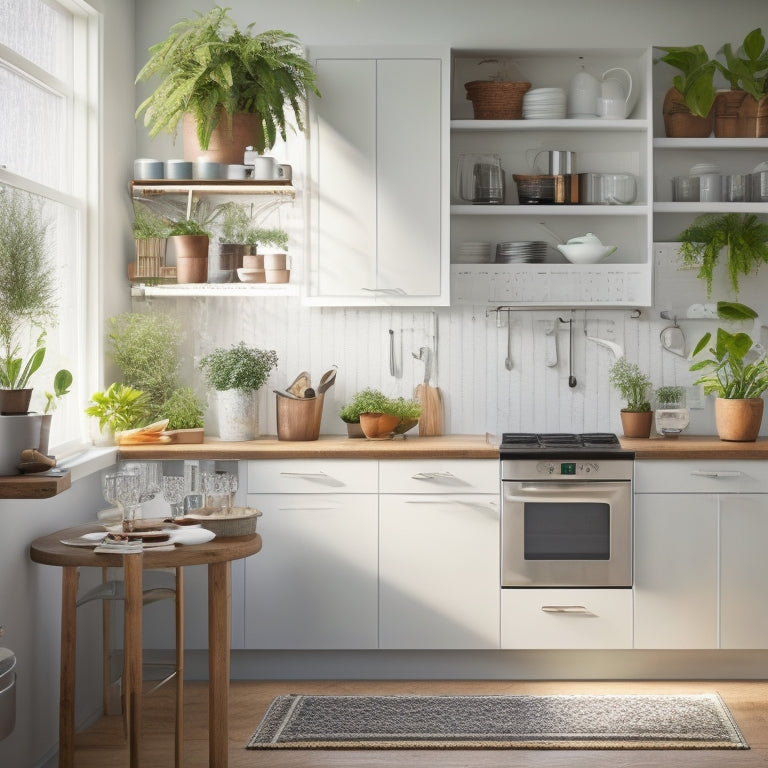
Revamp Your Kitchen: Organize for Success
Share
I've learned that to achieve long-term kitchen organization, I need to approach it strategically. First, I clear out cluttered areas and evaluate items based on frequency of use, getting rid of unnecessary ones. Then, I maximize storage and assign logical placements for each item. Next, I identify essential tools and optimize their placement for easy access. I also implement a pantry organization system, using clear containers with labels to group similar items together. By following these steps, I'm able to create a kitchen space that's functional, efficient, and sustainable - and I'm excited to share the rest of my system to help you achieve the same success.
Key Takeaways
• Clear clutter, evaluate items by frequency of use, and get rid of unnecessary items to create a more efficient kitchen space.
• Assign prime real estate to essential tools and optimize their placement for easy access and frequent use.
• Implement a pantry organization system with clear containers, labels, and grouped similar items to maximize storage space.
• Practice inventory control by taking stock of pantry and fridge weekly, identifying staples that need replenishing, and avoiding unnecessary purchases.
• Prioritize health and quality in storage by opting for organic and non-GMO options, and choosing non-toxic materials for containers.
Streamlining Your Kitchen Space
To tackle the challenging task of streamlining my kitchen space, I begin by clearing out cluttered areas and evaluating each item based on its frequency of use, ruthless about getting rid of anything that's no longer serving a purpose.
Next, I focus on maximizing storage by assigning logical placements for each item, ensuring easy access and visibility. I also optimize the layout by grouping similar items together, creating a workflow that saves time and energy.
Evaluating Kitchen Essentials
My kitchen essentials, from pots and pans to utensils and gadgets, undergo a thorough evaluation to guarantee each item earns its place in my newly organized space.
I'm ruthless in my assessment, considering the frequency of use, unique purposes, and logical placements for easy access. Essential tools, like my trusty chef's knife and silicone spatulas, get prime real estate, while duplicates or rarely used items are donated or recycled.
As I evaluate, I also think about pantry organization, ensuring that similar items are grouped together and easily accessible.
Mastering Food Storage Strategies
With my kitchen essentials in their designated spots, I turn my attention to mastering food storage strategies that will keep my pantry and fridge organized, functional, and efficient.
I start by implementing a pantry organization system that assigns a clear home for every item. I use clear containers with labels to facilitate quick inventory assessment and easy stacking. Container labeling is essential, as it guarantees I can identify contents at a glance and prevents unnecessary repurchases.
I group similar items together and utilize different container sizes to maximize storage space. By implementing proper food rotation and keeping bulk items accessible, I can make sure that my kitchen remains clutter-free and functional.
Efficient Supply Management
Every week, I take stock of my pantry and fridge to identify which staples need replenishing, ensuring I maintain a well-stocked kitchen without overbuying or running out of essentials.
This habit helps me practice inventory control and supply optimization. By doing so, I avoid unnecessary purchases and reduce food waste.
Here are some key strategies I use to optimize my supply management:
- I prioritize non-perishable items that are close to expiring, making sure to use them before they go bad.
- I maintain a running list of staples that need to be replenished, ensuring I never run out of essentials.
- I set a budget for groceries and stick to it, avoiding impulse buys that can disrupt my supply optimization.
Healthy Storage for the Future
Opting for organic and non-GMO options, I affirm that my storage solutions prioritize health and quality, safeguarding my family's well-being for the long haul.
I'm committed to healthy storage for the future, focusing on long-term preservation and sustainable solutions. This means selecting containers made from non-toxic materials, like glass or stainless steel, and avoiding plastic or BPA-laced containers that can leach chemicals into food.
By choosing eco-friendly storage solutions, I reduce my environmental footprint and ensure a healthier future for my family.
With a well-planned storage system, I can maintain a consistent supply of nutritious food, reducing waste and supporting a more sustainable lifestyle.
Frequently Asked Questions
How Do I Maintain Organization in a Small Kitchen With Limited Storage?
"I tackle my small kitchen's limited storage by maximizing vertical space with stackable shelves and utilizing hidden storage like drawer dividers, under-sink compartments, and magnetic spice strips to keep essentials within easy reach."
Can I Still Keep Sentimental Kitchen Items Without Compromising Organization?
Like a curator of a precious art collection, I carefully balance sentimental items with organization, assigning them a designated spot in clever storage solutions, ensuring my sentimental keepsakes don't clutter my kitchen, but remain treasured and accessible.
What Are Some Creative Ways to Repurpose Old Kitchen Items for Storage?
I love repurposing old kitchen items for storage; I've turned vintage mason jars into decorative storage containers, upcycled old utensil holders into spice racks, and transformed worn-out cutting boards into clever drawer dividers.
How Often Should I Reassess and Reorganize My Kitchen and Food Storage?
'Like a medieval knight preparing for battle, I ready my kitchen for culinary conquests by decluttering regularly and updating my layout every 3-6 months to guarantee my food storage and kitchen remain a well-oiled machine.'
Are There Any Specific Organization Strategies for Kitchen Utensils and Gadgets?
When organizing kitchen utensils and gadgets, I use drawer dividers and hanging hooks to maximize vertical storage, and decluttering tips like categorizing and grouping similar items to create a system that makes sense for me.